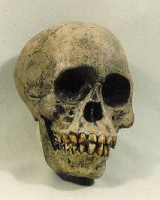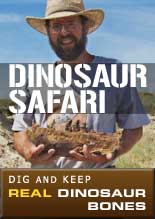
The Australopithecus africanus Skull (Taung Child) was discovered by M. de Bruyn in Taung, South Africa in 1924. It is believed to be 2.3 million years old. Anatomy professor Raymond Dart identified this juvenile skull as a new genus and species of hominid in 1925 in Nature (Australopithecus africanus, which means "southern ape of Africa"). Dart considered his new man-like ape to be intermediate between humans and apes. The skull, though immature, features several hominid-like characteristics including: a rounded, high forehead lacking browridges, rounded dental arcade, no space between canine and first lower premolar, and a foramen magnum (the hole under the skull from which the spinal cord emerges) positioned forwardly under the skull, indicating bipedal locomotion. On the other hand, the child's cranial capacity is estimated at 405 cc, with a projected adult size of 440 cc., well within the ape range. It was not until other, adult, specimens were discovered in southern Africa during the next twenty years that Australopithecus africanus began to gain acceptance in the established scientific community.
resin
4 inches high
Item 1565
Category: Replicas
Type: Skulls
Phylum: Vertebrates
Class: Hominids & Humans
MORE PHOTOS:


Now Over 1,000 Items!
PrehistoricStore.com offers the largest selection of replica fossils and other fossil-related products anywhere in the world!
Download a Full Catalog (3MB PDF)
OVER 260 PAGES OF REPLICAS AND MORE!
